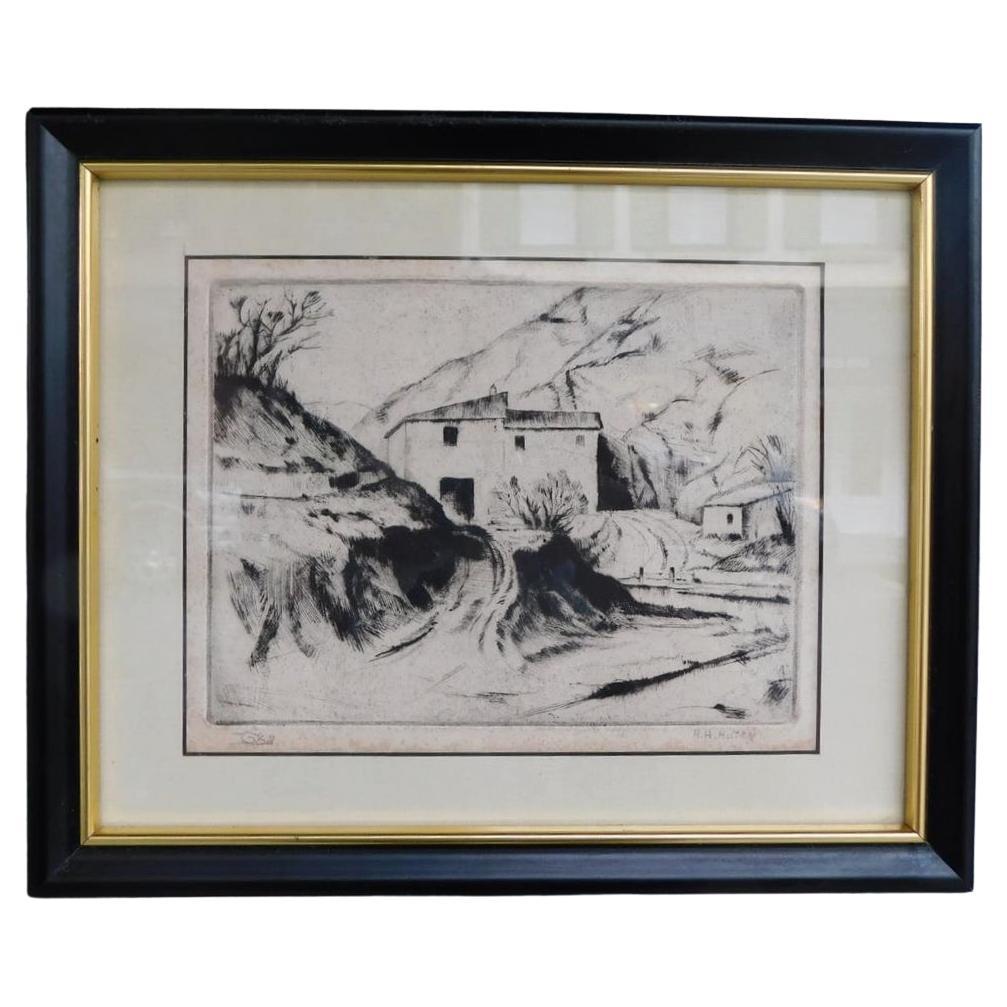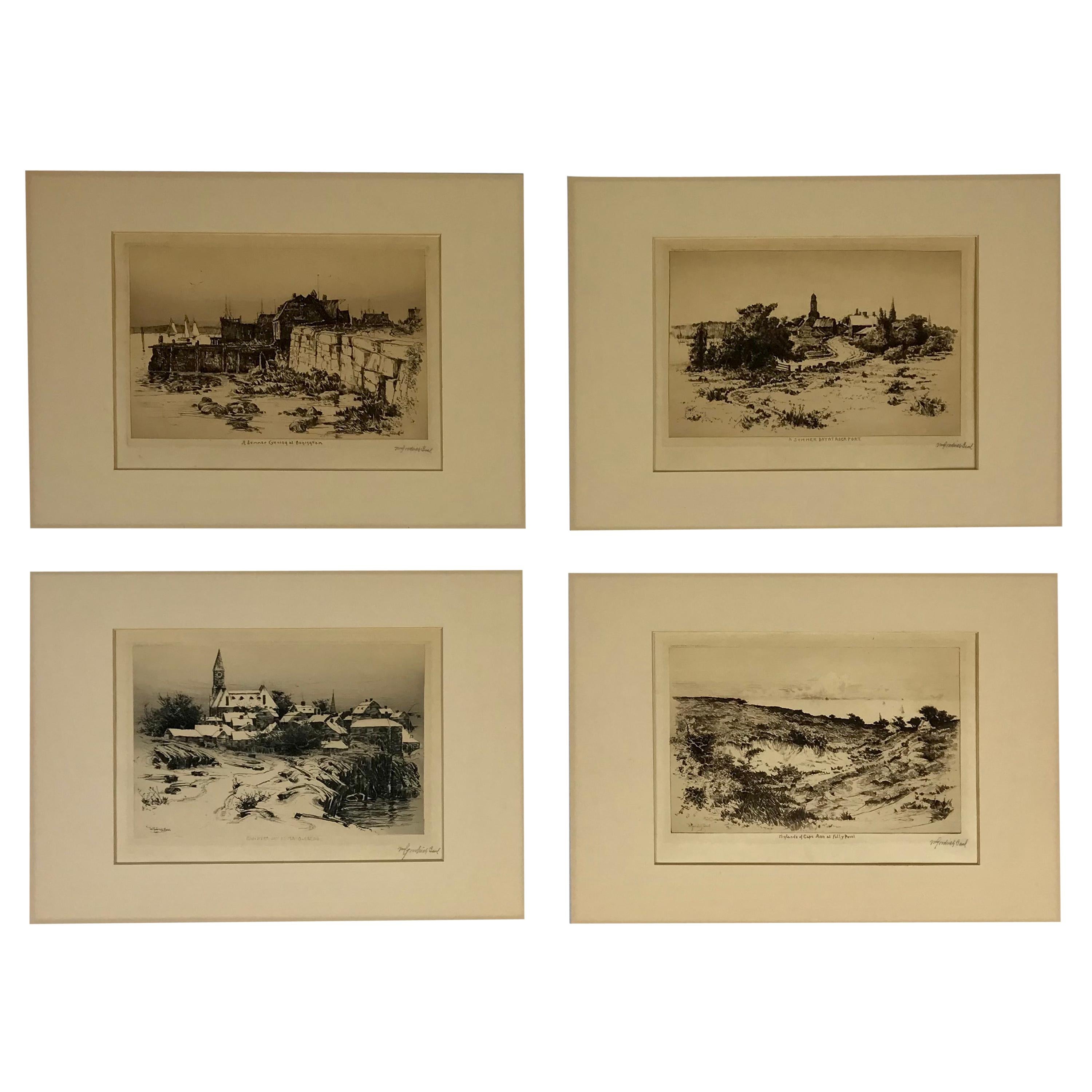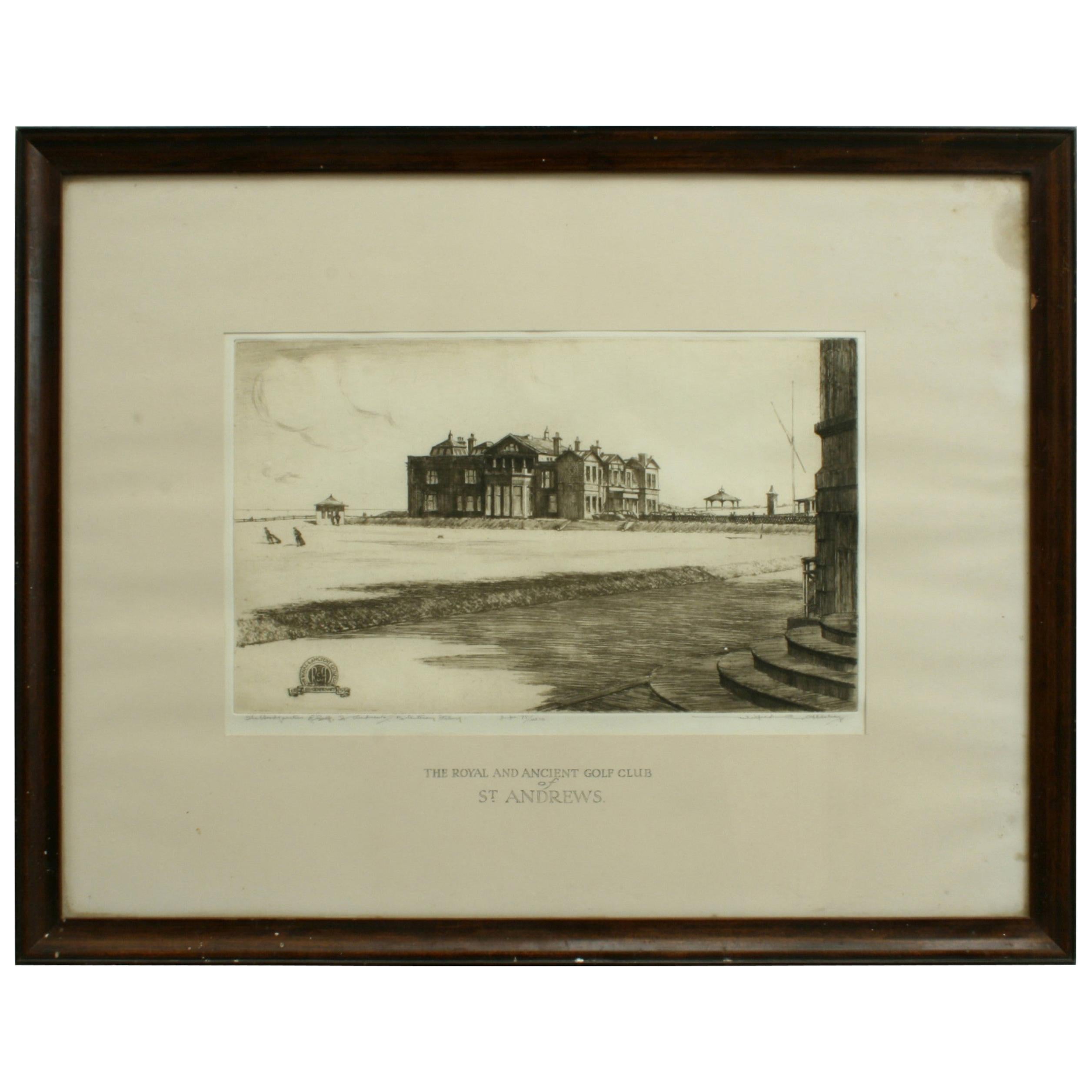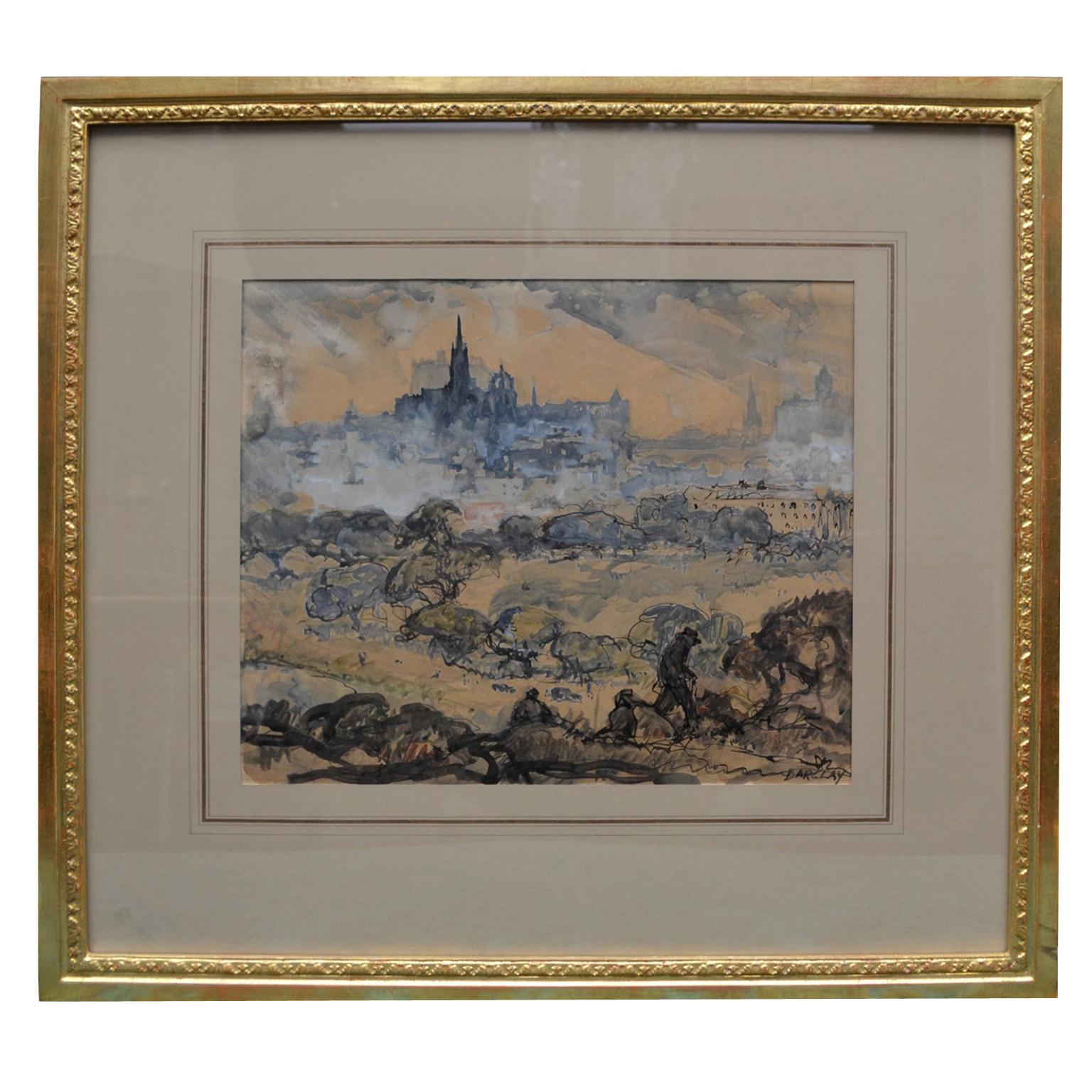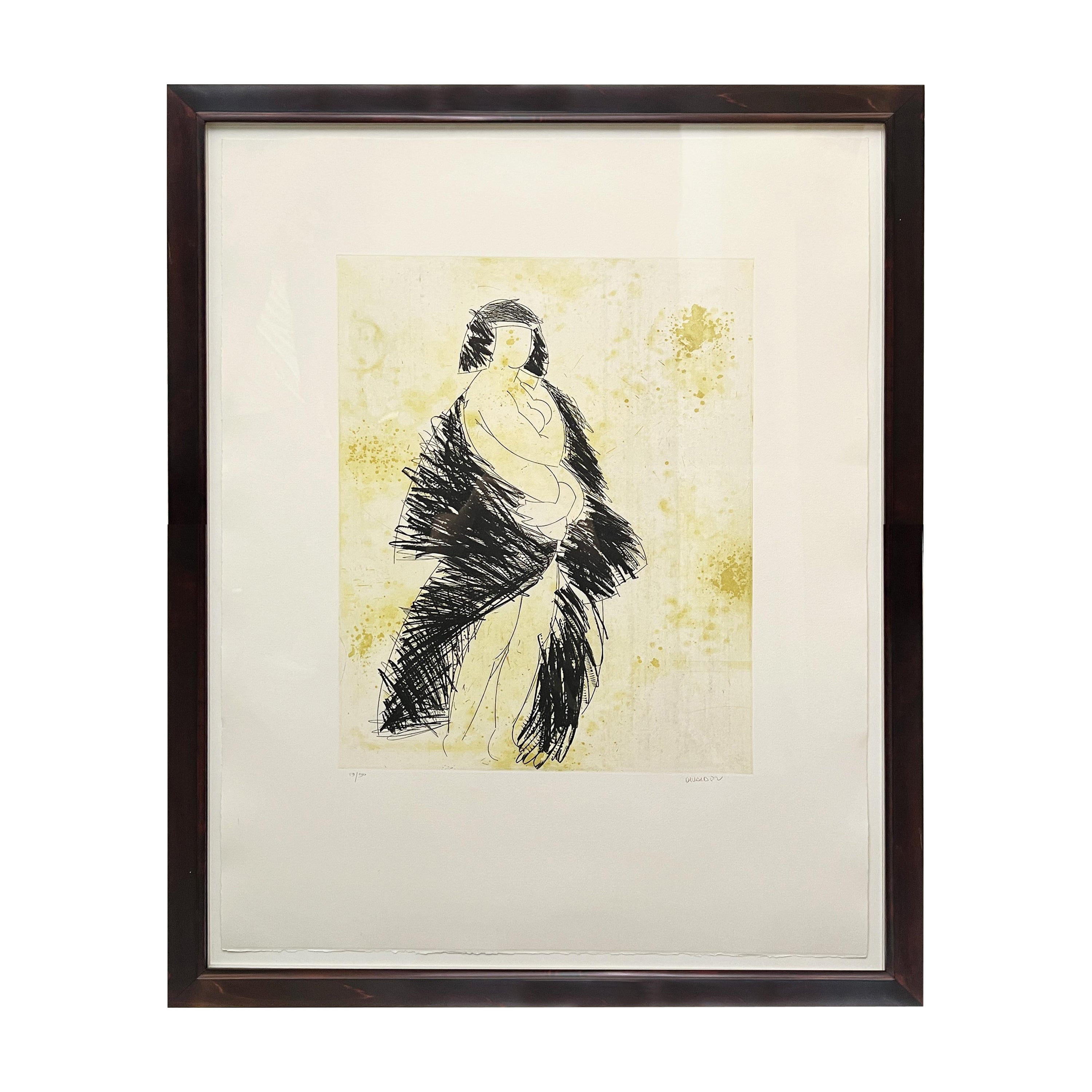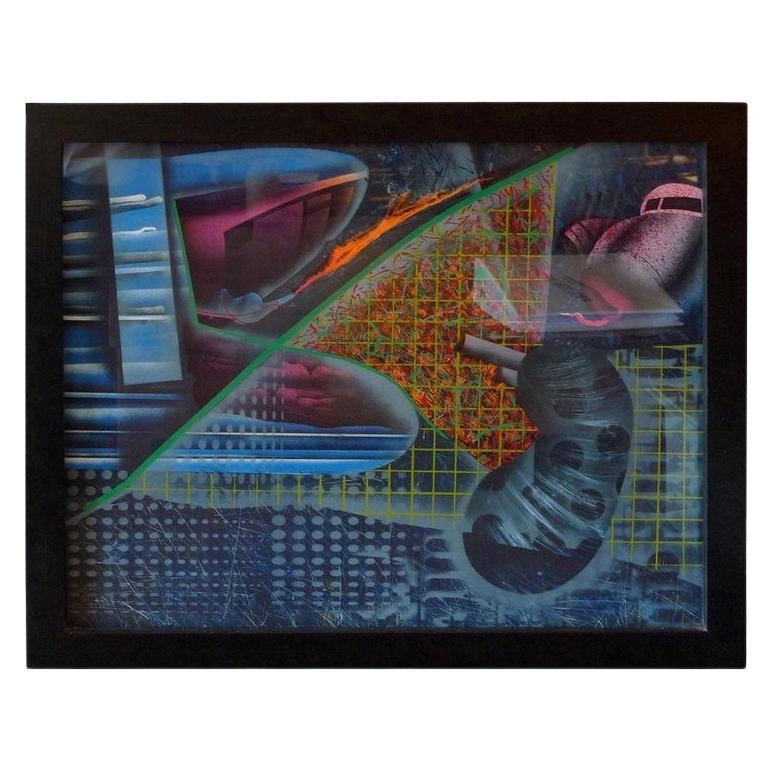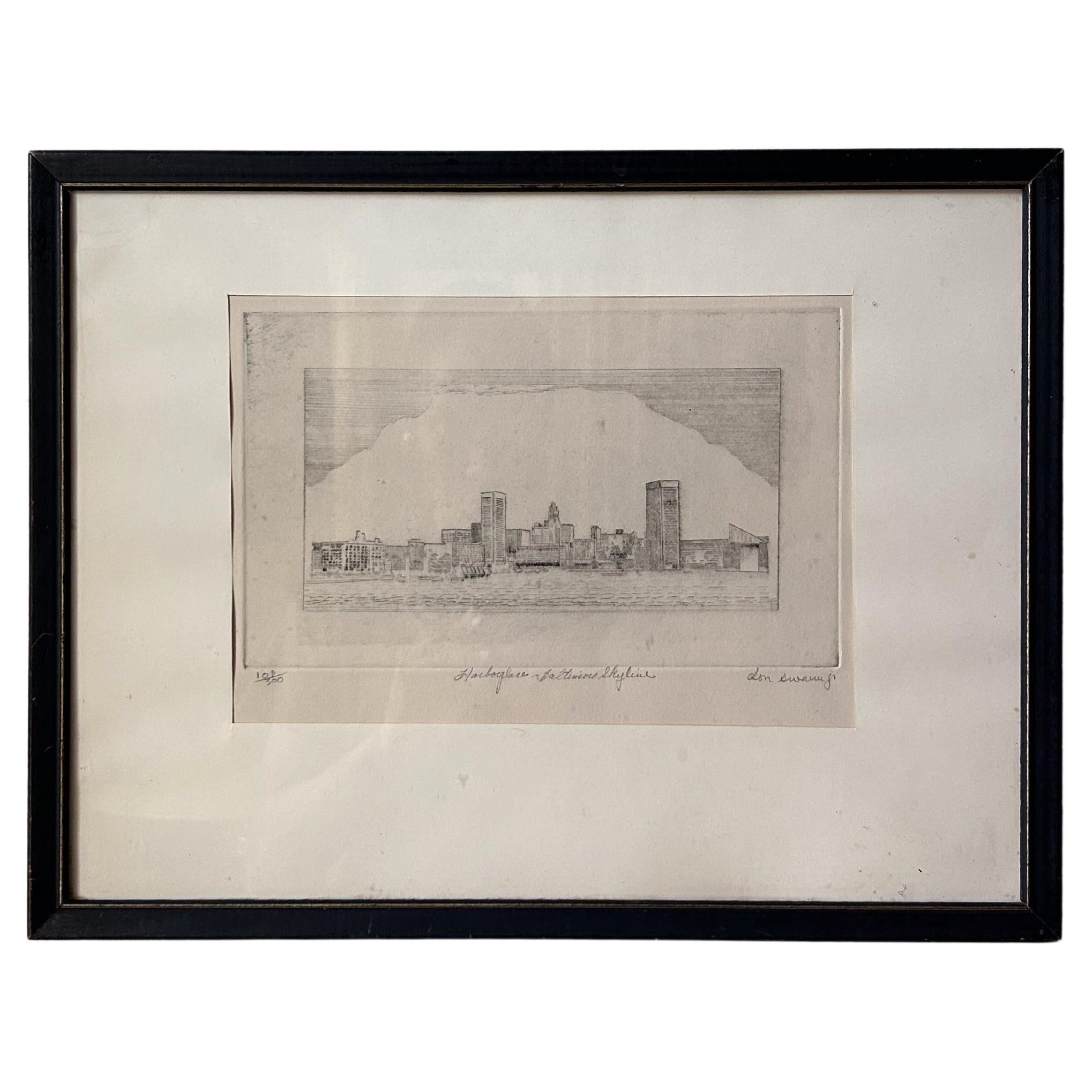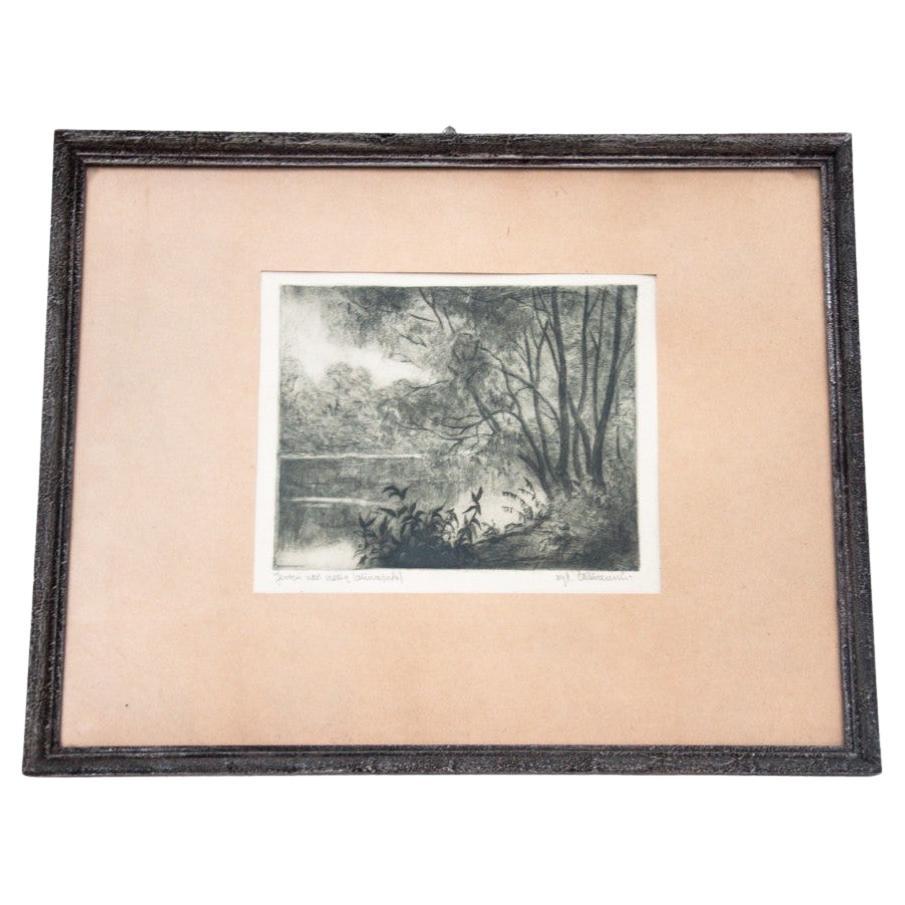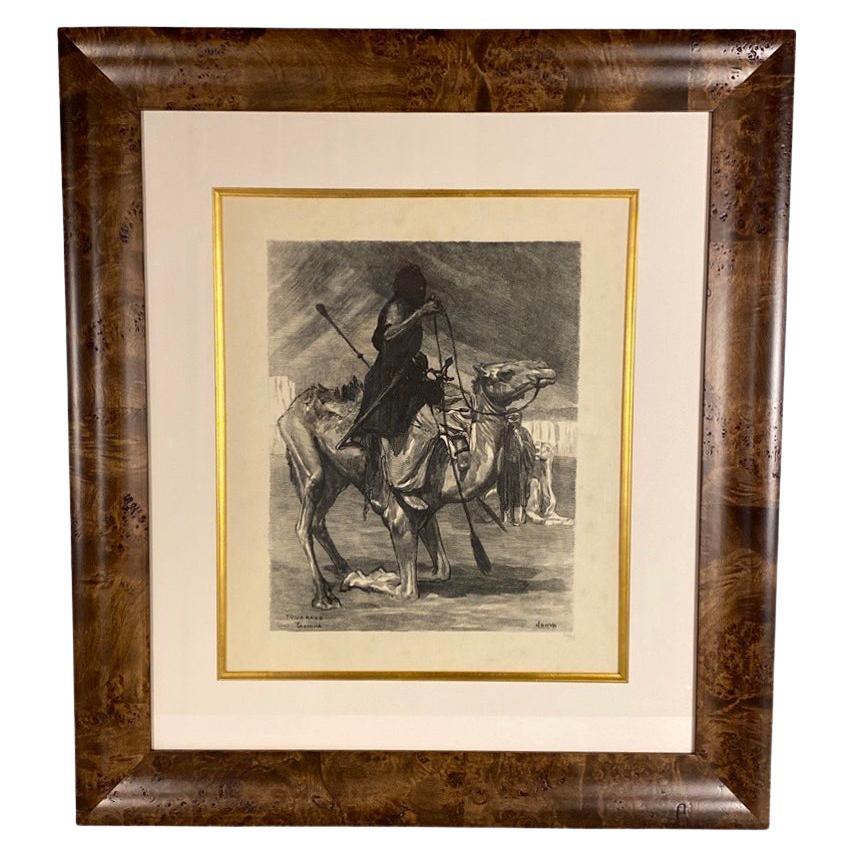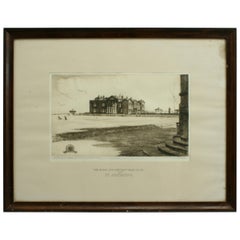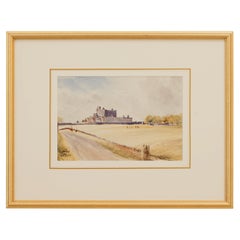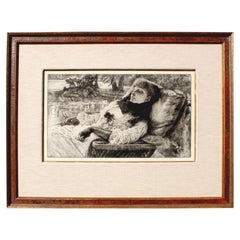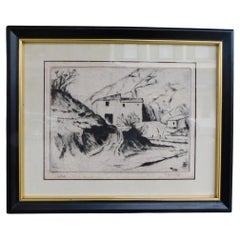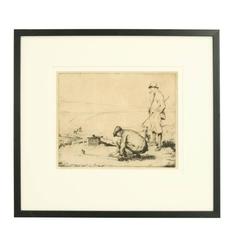
Golfing Picture, Dry Point Etching by John R. Barclay
View Similar Items
Want more images or videos?
Request additional images or videos from the seller
1 of 3
Golfing Picture, Dry Point Etching by John R. Barclay
About the Item
- Dimensions:Height: 8.08 in (20.5 cm)Width: 10.04 in (25.5 cm)Depth: 0.04 in (1 mm)
- Place of Origin:Scotland
- Period:
- Date of Manufacture:circa 1922
- Condition:
- Seller Location:Oxfordshire, GB
- Reference Number:Seller: 259481stDibs: LU97574410813
About the Seller
5.0
Platinum Seller
These expertly vetted sellers are 1stDibs' most experienced sellers and are rated highest by our customers.
Established in 1977
1stDibs seller since 2013
691 sales on 1stDibs
Typical response time: 1 hour
Associations
LAPADA - The Association of Arts & Antiques Dealers
More From This SellerView All
- St Andrews Golf Club, Bicentenary Etching, Ltd Edition 10/75Located in Oxfordshire, GBSt Andrews golf club bicentenary etching. A rare etching of the Royal and Ancient Golf Club St Andrews Clubhouse, produced as Ltd. edition for the...Category
Mid-20th Century British Sporting Art Drawings
MaterialsPaper
- Lion & Lioness, Herbert Dicksee, Marauders African Wildlife PictureLocated in Oxfordshire, GBMarauders, antique etching by Herbert Dicksee. A wonderful framed etching by Herbert Dicksee of a lion and lioness, Marauders. The black and white wildlife picture shows a lion and ...Category
Vintage 1910s British Sporting Art Drawings
MaterialsPaper
- Golf Painting by John Blair, Craigmillar Park G CLocated in Oxfordshire, GBCraigmillar Park Golf Club Watercolour, John Blair. An atmospheric original watercolour of Craigmillar Park Golf Links in Edinburgh by the Scottish artist John Blair (1849-1934). Craigmillar Castle from which the club derives its name from is clearly seen in the background and the painting is signed to the lower left corner. Craigmillar Castle was a haunt of Mary Queen of Scots, the world's first recorded lady golfer. How ironic then, that since the golf club's inception equality of the sexes was the rule at Craigmillar Park. John Blair was a Scottish painter, predominantly of watercolour landscapes. Of humble beginnings in Berwickshire, he moved to Edinburgh to study and spent the rest of his life there. His paintings mainly reflect the landscapes around him, both of urban settings and also of the castles, sea and lochs of the Borders. As well as his original work, his paintings were viewed by a wide audience in the form of picture postcards, book endpapers and illustrations. Taken from Craigmillar Park Golf Club website:- Craigmillar Park Golf Club was constituted in 1895 and moved to its present location in 1907. It was extended to 18 holes (designed by James Braid) in 1927. On 12th of January 1895 the Scotsman newspaper carried the following "birth" announcement : "NEW GOLF COURSE IN THE SOUTH SIDE OF EDINBURGH. A nine-hole golf course is being formed at Craigmillar Park and is expected to be ready for play in February. A lease of the ground which extends from Crawfurd Road to Lady Road has been obtained from Captain Gordon Gilmour of Liberton and Craigmillar. The principal entrance will be from Crawfurd Road within three minutes' walk of the Craigmillar Park car terminus and Newington Suburban Station. The course is about a mile in length and has been laid out by Mr. Day of Musselburgh, who has given a very favourable report of the suitability of the ground for the purpose. Already about 150 ladies and gentlemen have been admitted as members of the club." Many, perhaps most, of the new clubs created about the same time as Craigmillar Park were (and some continue) as male preserves. It is clear that from the outset equality of the sexes was the rule at Craigmillar Park, although it was not until 1914 that the subscriptions were equalised. The course was situated in an area of land close to Newington Railway Station and the Newington Bus and Tram Terminus and was thus, easily accessible. In those days there was very little building development between the course and the iconic Craigmillar Castle from which the club derives its name. The castle was a haunt of Mary Queen of Scots, the world's first recorded lady golfer. How ironic then, that since the golf club's inception, ladies have had equal status with men and there was no gender barrier to any office. This was in an age when golf clubs were regarded as male preserves. In 1914, ladies started paying exactly the same subscription as their male counterparts and this has remained right up to the present day. When you consider that all women did not get the vote until 1928, Craigmillar Park Golf Club were indeed trendsetters! Despite the club's early success, with 400 members and a waiting list, they were dealt a blow when their course at Newington was taken over for housing development. They decided, rather than to disband, to relocate the golf course to the eastern slopes of the Blackford Hill in 1907. Once again the close proximity of Blackford Railway Station and Bus Terminus were factors in their decision making. Another factor in choosing Blackford Hill was the potential for increasing the length of the 9 holes that had been played for in the course at Newington and possibly even converting the new course to 18 holes at some future date. This is in fact what happened and James Braid designed a splendid 18 hole course which officially opened in 1927. The new course was a real test of golf with no two holes being the same. The course boasts marvellous views over Edinburgh and Fife and down the coast to the Berwick Law, Bass Rock...Category
Antique Early 1900s European Sporting Art Sports Equipment and Memorabilia
MaterialsPaper
- Antique St Andrews Golf Etching by W.L. Wyllie, circa 1900Located in Oxfordshire, GBA very charming etching of two children playing golf on the beach at St Andrews, in the background is the town of St Andrews with the Castle & Cathedral prominent in the sky line. Fr...Category
Antique Early 1900s British Sporting Art Sports Equipment and Memorabilia
MaterialsWood, Paper
- Westward Ho! (Royal North Devon Golf Club) 6th Green Golf Picture, Cecil AldinBy Cecil AldinLocated in Oxfordshire, GBCecil Aldin Golf Print, Westward Ho!- THE 6th GREEN. A colourful framed golf photolithograph of Westward Ho! (Royal North Devon Golf Club) 6th Green. Signed in pencil in the lower le...Category
Vintage 1920s British Sporting Art Decorative Art
MaterialsPaper
- Golf Oil Painting of Dr. William Laidlaw Purves by Hon. John CollierBy John CollierLocated in Oxfordshire, GBImpressive modern Golf Portrait, William Laidlaw Purves. Large oil on canvas of Dr. William Laidlaw Purves after the original oil painting by the Hon. John Collier (1850 - 1934), a prominent London artist. The painting is un-framed but is stretched and ready to hang, artist of this particular painting is unknown. The original painting now hangs at Royal St. George's, Sandwich. William Laidlaw Purves, oculist and obsessive golfer, was an Edinburgh born surgeon who worked in London, but remembered by most for his contributions to the golfing world. A very influential man, he was one of the key figures behind the spread of the game of golf in England towards the end of the 19th century. He won many important club trophies, the last being in 1914, aged 71 with a handicap of 3. He died at his home Hardwick Cottage, Wimbledon Common on 30th December 1917, and at the time he was a member of no fewer than 32 golf clubs. As a student Purves had played golf at Bruntsfield Links in Edinburgh and by the time of his London appointment he was a member of both the Honorable Company of Edinburgh Golfers and the Royal and Ancient Golf Club of St Andrews. Upon his move to London in 1874 he joined the London Scottish and Wimbledon Golf Club. The two clubs shortly separated into two separate clubs, The London Scottish Golf Club and the Wimbledon Golf Club, but both continued to play on Wimbledon Common. In 1882 the Wimbledon became the Royal Wimbledon Golf Club and Purves became an active committee member, later being elected Captain. As the two clubs also shared the Common with the public play was restricted, so together with a fellow Scot and keen amateur golfer (Henry Lamb...Category
2010s European Sporting Art Sports Equipment and Memorabilia
MaterialsCanvas
You May Also Like
- James Jacques Joseph Tissot "Soirée d'été" 'Summer Evening' Etching & Dry PointBy James TissotLocated in Los Angeles, CAA fine French 19th century etching and drypoint Titled "Soirée d'été" (Summer Evening) by Jacques Joseph Tissot (French, 1836-1902) depicting Mrs. Kathleen Newton resting on a lounge chair. Signed and dated (l/l): J.J. Tissot, 1881 in the plate. Under the mat, the front of the sheet inscribed in pencil with a '1' in a circle, the verso of the sheet with old price inscription "450-" in pencil. Circa: 1881-1882. Measures: Plate Height: 9 inches (22.9 cm) Plate Width: 15 1/2 inches (39.4 cm) Sheet Height: 14 1/2 inches (36.8 cm) Sheet Width: 20 5/8 inches (52.4 cm) Frame Height: 19 inches (48.3 cm) Frame Width: 24 1/2 inches (62.2 cm) Frame Depth: 1 1/8 inches (2.9 cm) Literature: Wentworth 56. Note: Tissot's from 1881 is said to depict his lover, the Irish divorcee Mrs. Kathleen Newton, resting on a lounge chair. Provenance: Private collection, Los Angeles, California Jacques Joseph Tissot (French, 15 October 1836 – 8 August 1902), Anglicized as James Tissot, was a French painter and illustrator. He was a successful painter of Paris society before moving to London in 1871. He became famous as a genre painter of fashionably dressed women shown in various scenes of everyday life. He also painted scenes and characters from the Bible. Jacques Tissot was born in the city of Nantes in France and spent his early childhood there. His father, Marcel Théodore Tissot, was a successful drapery merchant. His mother, Marie Durand, assisted her husband in the family business and designed hats. A devout Catholic, Tissot's mother instilled pious devotion in the future artist from a very young age. Tissot's youth spent in Nantes likely contributed to his frequent depiction of shipping vessels and boats in his later works. The involvement of his parents in the fashion industry is believed to have been an influence on his painting style, as he depicted women's clothing in fine detail. By the time Tissot was 17, he knew he wanted to pursue painting as a career. His father opposed this, preferring his son to follow a business profession, but the young Tissot gained his mother's support for his chosen vocation. Around this time, he began using the given name of James. By 1854 he was commonly known as James Tissot; he may have adopted it because of his increasing interest in everything English. In 1856 or 1857, Tissot travelled to Paris to pursue an education in art. While staying with a friend of his mother, painter Elie Delaunay, Tissot enrolled at the Ecole des Beaux-Arts to study in the studios of Hippolyte Flandrin and Louis Lamothe. Both were successful Lyonnaise painters who moved to Paris to study under Jean-Auguste-Dominique Ingres. Lamothe provided the majority of Tissot's studio education, and the young artist studied on his own by copying works at the Louvre, as did most other artists of the time in their early years. Around this time, Tissot also made the acquaintance of the American James McNeill Whistler, and French painters Edgar Degas (who had also been a student of Lamothe and a friend of Delaunay), and Édouard Manet. In 1859, Tissot exhibited in the Paris Salon for the first time. He showed five paintings of scenes from the Middle Ages, many depicting scenes from Goethe's Faust. These works show the influence in his work of the Belgian painter Henri Leys (Jan August Hendrik Leys), whom Tissot had met in Antwerp earlier that same year. Other influences include the works of the German painters Peter Von Cornelius and Moritz Retzsch. After Tissot had first exhibited at the Salon and before he had been awarded a medal, the French government paid 5,000 francs for his depiction of The Meeting of Faust and Marguerite in 1860, with the painting being exhibited at the Salon the following year, together with a portrait and other paintings. Émile Péreire supplied Tissot's painting Walk in the Snow for the 1862 international exhibition in London; the next year three paintings by Tissot were displayed at the London gallery of Ernest Gambart. In about 1863, Tissot suddenly shifted his focus from the medieval style to the depiction of modern life through portraits. During this period, Tissot gained high critical acclaim, and quickly became a success as an artist. Like contemporaries such as Alfred Stevens and Claude Monet, Tissot also explored Japonisme, including Japanese objects and costumes in his pictures and expressing style influence. Degas painted a portrait of Tissot from these years (Metropolitan Museum of Art, New York), in which he is sitting below a Japanese screen hanging on the wall. Still on Top, 1873 Tissot fought in the Franco-Prussian War as part of the improvised defense of Paris, joining two companies of the Garde Nationale and later as part of the Paris Commune. His 1870 painting La Partie Carrée (The Foursome) evoked the period of the French revolution. Either because of the radical political associations related to the Paris Commune (which he was believed to have joined mostly to protect his own belongings rather than for shared ideology), or because of better opportunities, he left Paris for London in 1871. During this period, Seymour Haden helped him to learn etching techniques. Having already worked as a caricaturist for Thomas Gibson Bowles, the owner of the magazine Vanity Fair, as well as exhibited at the Royal Academy, Tissot arrived with established social and artistic connections in London. Tissot used...Category
Antique Late 19th Century French Victorian Drawings
MaterialsGlass, Wood, Paper
$4,850 Sale Price24% Off - American Dry Point Engraved Etching Italian House on Hill Side, A. Hutty C 1920By Alfred HuttyLocated in Hollywood, SCAmerican dry point engraved landscape etching Italian House on Hill Side, Alfred H. Hutty, Early 20th centuryCategory
Vintage 1920s American Modern Drawings
MaterialsPaper
- 4 Etchings by WG Beal, Marblehead, Rock Port, Folly Point & Annisquam, 1880's MALocated in Bedford Hills, NYSet of four etchings by American artist William Goodrich Beal, circa 1880s. Scenic Massachusetts coastal towns and beaches. All signed in pencil, lower right corner. American Arti...Category
Antique 1880s American American Classical Prints
MaterialsPaper
- Water Color of the Cambridge Skyline Signed BarclayBy John Rankin BarclayLocated in Vancouver, British ColumbiaAn atmospheric impressionist style water colour of the skyline of the English University Town of Cambridge all done in pastel inspired colours. The work is boldly signed Barclay at t...Category
Antique Late 19th Century English Other Drawings
MaterialsPaper
$1,440 Sale Price20% Off - Etching by Manolo ValdesBy Manolo ValdésLocated in New York, NYEtching by Manolo Valdes, depicting a naked silhouette of a woman covered by a black blanket. Manolo Valdes is one of few artists today who has successfu...Category
20th Century Spanish Drawings
MaterialsPaper
$10,000 - Watercolor by John Varley, 1812By Ernest William VarleyLocated in Kittery Point, ME'Llanberis Lake at the Foot of Mount Snowdon' in Wales. Watercolor on paper, signed and dated "J. Varley 1812" ll, identifying info on verso. sight size: 8 x 19 3/4 in. John Varley is known as an English landscape painter in watercolor and a close friend of William Blake. Varley represents the transition between tinted topographical drawing and the bolder, more fully developed manner of watercolor painting characteristic of the 19th century. As well as being a leading painter, he was the most popular and enthusiastic teacher of his day: his pupils included Cox, De Wint, Linnell, Mulready (his brother-in-law), and Samuel Palmer, and he published various instructional works, including one with Blake. In his early years Varley was influenced stylistically by the work of Thomas Girtin...Category
Antique 1810s English Neoclassical Drawings
MaterialsPaper
Recently Viewed
View AllMore Ways To Browse
Antique Framed Etching
Large White Picture Frame
Antique Etching Signed
Golf Watches
Golf Watch
Large Etchings Antique
Antique Needle Point
Antique Copper Picture Frames
Watch 1884
Antique 1920s Watch
Antique Ball Watch
Ball Watch Antique
Tee Antique
Antique Golf Ball
Antique Picture Frames 1920s
Antique Needle Point Furniture
Dry Point Etching Framed
Antique Golf Prints

